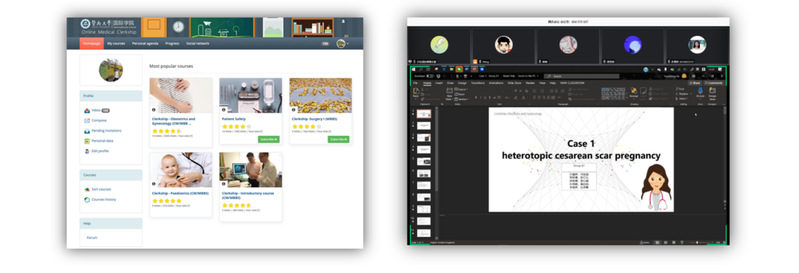May 8, Jinan University announced that undergraduate students who are unable to return to campus due to the pandemic prevention control would remain online classes throughout the spring semester. Online clinical clerkship becomes a reality for medical students, which was once just a temporary plan.
Video, check. Sound, check. Fourth-year students from Clinical Medicine program at Jinan University logged on to the online class platforms. A day of clinical clerkship began. Things went in order. Nevertheless, it still felt like something was missing.
On April 13, online clerkship began as a temporary plan. With concerns about potential COVID-19 cases, nearly a month after, Jinan University finally announced that students would be studying from home for this whole semester. The clerkship location for medical students has officially changed from hospital to the Internet.
 English simulation teaching platform built by the University(left) Students making presentation on Tencent Meeting(right)
English simulation teaching platform built by the University(left) Students making presentation on Tencent Meeting(right)
Normally, students would immerse themselves in the clerkship experience by having interaction with patients in a hospital. “If without real practice or observation, it will just empty talk,” said Liu Jiahe, a fourth-year medical student, when he first heard the news.
Difficulties emerged. “Some teachers could just talk on the PowerPoints or play videos for us throughout the lecture,” Qiao Jinlong, another fourth-year student, said, “One teacher went on live video for us when taking ward rounds. But not every patient agrees to be on camera.”
Though shortages were inevitable, students expressed their understanding of online clerkship. Qiao said, “It is the only way out. I know teachers have been looking for ways to resolve the issues.”
“Teachers had to spend more time in designing courses and developing back-up plans,” said Ming Weijie, an associate professor in the Department of Public Health and Preventive Medicine, “Online clerkship is the last resort under special circumstances. We’ve been tweaking teaching methods just to make sure the online clerkship meets medical students’ needs.”
Though Liu had doubts, he admitted that he enjoyed Professor Ming’s clerkship: “Teachers adopt the problem-based learning method. They post cases and clinical questions to be discussed on the platform one day ahead. We can look for relevant information, then discuss and present our findings in class.” Though it was not as ideal as the traditional medical clerkship, he still thought it helped him gain a systematic understanding of the diseases.
Joe Varughese, an internationalstudent in medicine major, appreciated what Jinan University has done, “Many well-named universities in India and Bahrain are still lagging behind their academics and trying to cope with things online,” He said, “Whereas our University has things sorted and done so smoothly.”
Josephine Song, a staff member from the teaching affairs office, said: “As patients rarely speak English in China, teachers provide materials in English during clerkship for students, so the language barriers can be overcome,” she added, “And those who feel lost can pause the video and re-play it at any time.”
Under the circumstances that the government calls for the normalization of epidemic prevention and control, online teaching is one of the back-up plans the University has been developing just in case. There is still a lot to be discussed with online education for medical students, but Song and Professor Ming both hold positive opinion regarding its future.
“Educational technologies like this will be here to stay. The teaching style that adopts online-to-offline model may become a trend for the future,” Professor Ming said.
Journalists: Cutie, Joyce Ye
Date: May 30, 2020






